 |
 |
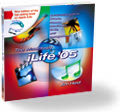 |
Friday, July 23, 2004
Posted 11:03 AM
Forget AirPort Express: Say Hello to iHome
Now that Apple has shipped its AirPort Express portable base station and music sharing doodad, everyone seems to be talking about streaming music throughout their houses.
Jonathan Q. Woolson is way ahead of them.
Jonathan is the superbly talented designer and compositor who has produced all three editions of my iLife book, not to mention the eBay seller's guide that I co-authored with Toby Malina.
He's also a serious Mac geek.
He recently wrote to tell me about a home media system that he created using a variety of off-the-shelf components -- including a PowerBook G4 with a broken screen that he bought on eBay.
He calls his system iHome, and here, in his words, is how he describes it.
The Goal
Integrate our computer, audio, and video devices into a single, switchable system to make it easy to listen to music from iTunes or record audio and video to disk for editing and archiving.
Primary Components
1. PowerBook G4/550.
2. Samsung 170MP 17" LCD monitor w/TV tuner.
3. Formac Studio/TV tuner FireWire A/D AV converter.
4. Two AV source selector boxes that allow just about any audio or
video input to be routed to any output (TV, Stereo, DV converter, and so on)
5. A stereo/DVD home theater-type system.
PowerBook/Server
The PowerBook G4/550, dubbed an "iServe," is a wafer-thin (.75" slab) personal home server that sips power at 45 watts, has built-in Gigabit Ethernet and operates entirely autonomously in headless mode, running the Mac OS X 10.3 client (not the server edition). I've attached a La Cie 200GB FireWire drive to hold the iTunes music library.
I purchased the PowerBook/550 on eBay. It was advertised and sold with a broken screen. I removed the lid-screen assembly from the PowerBook, rendering it "headless" and helping to ensure that it would run cool.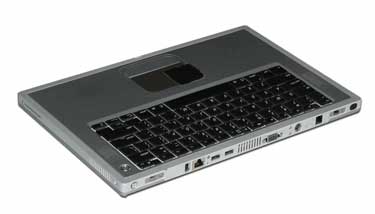 When I disassembled the lid/screen and disconnected its internal cables, I located the round, 1/8" magnet inside the lid that triggers the sleep switch beneath the PowerBook's trackpad.
When I disassembled the lid/screen and disconnected its internal cables, I located the round, 1/8" magnet inside the lid that triggers the sleep switch beneath the PowerBook's trackpad.
To trick the PowerBook into correctly feeding a single monitor/VGA output to the Samsung LCD and ignore its now-removed screen, I taped the magnet onto the trackpad directly above the sleep switch so that the PowerBook would run in "closed lid" mode. To keep the PowerBook running, I use a freeware utility called SleepLess. SleepLess keeps the computer running in closed-lid mode even when it is not connected to a VGA output (normally, disconnecting the VGA cable while in closed-lid mode causes the PowerBook to sleep immediately).
I keep the iServe and its external hard drive in a closet to minimize drive and fan noise. At a great electronics store in Boulder, CO, I found a very substantial aluminum heat sink for $25 that measures about 2-1/2" tall and 8" x 10". This oversized heat sink moves heat from the entire bottom of the PowerBook and alleviates the need to provide more fans, allowing the PowerBook to run safely in a closet that has minimal air movement. The PowerBook rarely spins its internal fans up to the first notch (there are two fan speeds on a TiBook/550).
Monitor/TV
The Samsung 170MP LCD monitor/TV is both the monitor for the iServe and the main general-purpose TV/DVD/VCR display for the house. Its flexibility enabled me to build this whole integrated system without having multiple screens for using the computer and for watching TV/DVD/VCR.
DV Converter
The Formac Studio/TV records video and television to disk. This provides TiVo-like function and converts VHS into iMovies.
AV Switch
The two-part AV switch is just two standard five-position AV switches that have their primary single AV outputs wired together so that any one of five AV inputs can be manually connected to any one of five AV outputs. They were sold for switching between different console video game systems and cost about $30 each.
The AV switch box assembly allows me to connect the video and audio from, say, the TV to the stereo, or the VHS to the TV, or the server's audio output to the stereo. One of the inputs is an 1/8" audio plug that can be plugged into any random/extra audio source like an iPod, a friend's laptop, or tape player to feed through the system for recording or playing through the stereo.
Stereo/DVD
The stereo is an integrated stereo and DVD/CD player home theater system.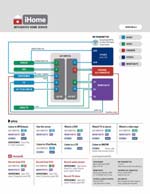 iHome Complete
iHome Complete
I've built a complete map of all the interconnections for whole system, which I call "iHome." The C. Crane FM transmitter broadcasts music/radio streams from the iServe out to radios in the kitchen and the bathroom.
Download the diagram (1MB PDF).
Hope you enjoy this bit of AV geekin'.
To learn more about Jonathan's design and computer consulting services, check out his Web site.
Thursday, July 22, 2004
Posted 8:19 AM
Announcing "Secrets of the Photoshop Masters, Volume 2": An Hour of High-Octane Photoshop CS, Made on Macs
It's a big day here today. For one thing, this week's issue of Apple's eNews newsletter has some kind things to say about The Macintosh iLife '04. It's always an honor to be featured in this widely read email newsletter, and I'm grateful.
For another, a project that I've been working on for the past several weeks has finally shipped. It's an instructional DVD called "Secrets of the Photoshop Masters, Volume 2", and it's from Avondale Media, the DVD- and seminar-production company for which I'm editorial director.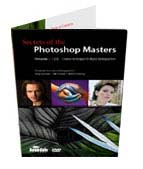 Our "Secrets of the Photoshop Masters" series of DVDs is different from other Photoshop training DVDs. They aren't one of those $150, 12-disc sets featuring one guy droning on and on about the marquee tool. Instead, our "Secrets" series is more like a portable Photoshop conference -- we bring award-winning photographers and artists into our studio and tell them to share their favorite techniques and tricks. The result is a tight, lively presentation that constantly makes you want to reach for the mouse and try things for yourself.
Our "Secrets of the Photoshop Masters" series of DVDs is different from other Photoshop training DVDs. They aren't one of those $150, 12-disc sets featuring one guy droning on and on about the marquee tool. Instead, our "Secrets" series is more like a portable Photoshop conference -- we bring award-winning photographers and artists into our studio and tell them to share their favorite techniques and tricks. The result is a tight, lively presentation that constantly makes you want to reach for the mouse and try things for yourself.
In Volume 2, we turned to three digital photography visionaries. Jeff Schewe is an advertising photographer in Chicago and the most brilliant digital imaging guru I know. It's frightening how much this man knows about Photoshop. Martin Evening is a spectacularly talented fashion photographer in London, and can also make Photoshop stand up on its hind legs and pose. Both Jeff and Martin are closely involved in the development and evolution of Photoshop.
And then there's Greg Gorman. Greg has been photographing entertainment industry stars for 35 years, having captured everyone from Alfred Hitchcock to Rachael Welch to Johnny Depp to Halle Barry. He's recently made the move to digital, and along the way, developed an amazing technique for turning color photos into black-and-white ones -- a technique that yields far more control over image tonality than a simple convert-to-grayscale operation.
That's the cast of "Secrets of the Photoshop Masters, Volume 2." Jeff Schewe demystifies the art and science of shooting in Raw format and working with Photoshop's Camera Raw module. Martin Evening shows how to create absolutely perfect image masks in a segment in which he superimposes a shot of a model against a New York street scene. And Greg Gorman philosophizes about his move to digital and then shows his black-and-white conversion technique.
It's an hour of absolutely inspiring Photoshop CS, and I couldn't be more proud of it. We've also included portfolios that let you see more work from these amazing artists, as well as detailed PDF articles about Camera Raw, image sharpening techniques, and more.
Enough of the hard sell. "Secrets of the Photoshop Masters, Volume 2" costs $49.95 and it'll change the way you use Photoshop CS.
And, of course, it was made on a Mac: we ran Photoshop CS on a dual-processor G5, we captured the video directly to hard drives using Final Cut Pro, we edited the video in Final Cut Pro, and we authored the DVD in DVD Studio Pro 3 -- while listening to iTunes, of course.
What a great computing platform.
Monday, July 19, 2004
Posted 8:06 AM
iPod Software Update Arrives; Old iPods Left Behind
I was right and I regret it.
In yesterday's post about the new, fourth-generation iPod, I wrote that Apple should make some of the new iPod's enhanced menu features available to users of older iPods -- but I predicted that it wouldn't happen.
It hasn't.
Apple has indeed released a new software update for the iPods, and it does not add revamped menus and enhanced on-the-go playlist support to third-generation or earlier iPods, not even the iPod mini.
That's too bad. As I said yesterday, throwing a little bone to buyers of older iPods would be a nice consolation, a way of saying, "Yeah, so your iPod isn't the very latest one anymore. Here's a little something to make you feel better."
And the fact that the new menus and on-the-go playlist features will not be available for iPod minis introduces a new quandry for iPod buyers. Until now, the only major difference between the big and little iPods was their size. (A few dock-connector accessories don't work with the iPod mini, but who cares?)
Now, however, buyers must consider whether they also need or want the additional goodies that the fourth-generation iPod provides: the new menu scheme, the new playlist features, the audiobook speed-up/slow-down features, and so on. Buyers must compare the two iPod families carefully -- and the mini suddenly doesn't look as appealing as it did last week. The extra $50 that a new iPod costs over a mini now buys you a lot more than just several times the capacity.
Paving the Way for Photos and More?
And let me make one more Monday morning observation. The new iPod's main menu contains an item named Music. This marks the first time that the iPod user interface has required you to explicitly choose a Music command to get to your music.
So what? So this: it seems to me that this menu revamping paves the way for iPods in which other media are equal-class citizens to music.
Will we see a future iPod that also has a main menu item named Photos? Or Videos? Or Games? From a user-interface perspective, that foundation is now in place. Think of it this way: If Apple wasn't planning to make other media equal-class citizens, why add a main menu item for Music? Why have a menu item called Music for what is only a music player?
It's fun to speculate -- but in the end, it'd be more fun to be able to update my 3G iPod to have at least a few of the new capabilities of the newest iPod.
Sunday, July 18, 2004
Posted 12:48 PM
The New iPod and Your Old iPod: What Apple Should Include in an iPod Software Update
Newsweek magazine has details on a new, fourth-generation iPod as part of a cover story on the -- hold your nose -- iPod Nation.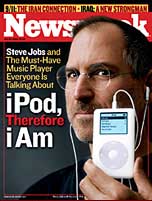
The quick skinny:
Same white case, and about the same size (about a millimeter thinner).
The four control buttons are replaced by a clickwheel, the lovely and versatile controller that first appeared on the iPod mini.
Menus have been reorganized, with Shuffle playback control making its way to the main menu.
Longer battery life betweeh charges -- up to 12 hours of playback time, thanks to better power management, according to the Newsweek article.
A C-note cheaper: 40GB for $399, 20GB for $299.
Some cool new features. According to Newsweek, "you can create multiple on-the-go playlists and delete songs from those ad hoc mixes. And audiobooks are not only easier to find, you can listen to them at normal speed, slower or 25 percent faster, without its sounding like a Munchkin."
So it looks like another solid step forward for the leading portable music player: a better user interface, better battery life, cool enhancements for audiobook listeners, and more options for creating and working with playlists while on the road.
Well and good. Now what about that third-generation iPod in your pocket?
It'll be interesting to see how many -- if any -- of these new features come to older iPods through a software update. Prediction: few if any. The real-time playback speed adjustments almost certainly require signal-processing hardware that only the 4G iPods will contain.
And while the revamped menus and enhanced on-the-go playlists would seem to be something Apple could give to owners of older iPods as a small obsolesence consolation, the company may want to withold these welcome additions to encourage upgrading. We've seen signs of this with previous iPod software updates.
I hope I'm wrong and that Apple releases an iPod software update that adds the enhanced menu and playlist features to 3G iPods and the iPod mini.
Prediction #2: Expect to see more iPods on eBay.
04/20/2003 - 04/26/2003
04/27/2003 - 05/03/2003
05/04/2003 - 05/10/2003
05/11/2003 - 05/17/2003
05/18/2003 - 05/24/2003
05/25/2003 - 05/31/2003
06/01/2003 - 06/07/2003
06/08/2003 - 06/14/2003
06/15/2003 - 06/21/2003
06/22/2003 - 06/28/2003
07/06/2003 - 07/12/2003
07/13/2003 - 07/19/2003
07/20/2003 - 07/26/2003
08/03/2003 - 08/09/2003
10/05/2003 - 10/11/2003
10/12/2003 - 10/18/2003
10/19/2003 - 10/25/2003
11/02/2003 - 11/08/2003
11/30/2003 - 12/06/2003
12/07/2003 - 12/13/2003
12/21/2003 - 12/27/2003
12/28/2003 - 01/03/2004
01/04/2004 - 01/10/2004
01/18/2004 - 01/24/2004
01/25/2004 - 01/31/2004
02/01/2004 - 02/07/2004
03/07/2004 - 03/13/2004
03/21/2004 - 03/27/2004
04/11/2004 - 04/17/2004
04/18/2004 - 04/24/2004
04/25/2004 - 05/01/2004
05/02/2004 - 05/08/2004
05/09/2004 - 05/15/2004
05/16/2004 - 05/22/2004
05/23/2004 - 05/29/2004
05/30/2004 - 06/05/2004
06/06/2004 - 06/12/2004
06/13/2004 - 06/19/2004
06/20/2004 - 06/26/2004
06/27/2004 - 07/03/2004
07/11/2004 - 07/17/2004
07/18/2004 - 07/24/2004
07/25/2004 - 07/31/2004
08/01/2004 - 08/07/2004
08/08/2004 - 08/14/2004
08/22/2004 - 08/28/2004
08/29/2004 - 09/04/2004
09/05/2004 - 09/11/2004
09/12/2004 - 09/18/2004
09/19/2004 - 09/25/2004
09/26/2004 - 10/02/2004
10/03/2004 - 10/09/2004
10/24/2004 - 10/30/2004
10/31/2004 - 11/06/2004
11/07/2004 - 11/13/2004
11/14/2004 - 11/20/2004
11/28/2004 - 12/04/2004
12/05/2004 - 12/11/2004
12/12/2004 - 12/18/2004
12/19/2004 - 12/25/2004
01/09/2005 - 01/15/2005
01/16/2005 - 01/22/2005
01/23/2005 - 01/29/2005
01/30/2005 - 02/05/2005
02/06/2005 - 02/12/2005
02/13/2005 - 02/19/2005
02/27/2005 - 03/05/2005
03/06/2005 - 03/12/2005
03/27/2005 - 04/02/2005
04/03/2005 - 04/09/2005
04/10/2005 - 04/16/2005
04/17/2005 - 04/23/2005
04/24/2005 - 04/30/2005
05/01/2005 - 05/07/2005
05/08/2005 - 05/14/2005
05/15/2005 - 05/21/2005
05/22/2005 - 05/28/2005
05/29/2005 - 06/04/2005
06/05/2005 - 06/11/2005
06/12/2005 - 06/18/2005
Really old stuff (before February 2003)

